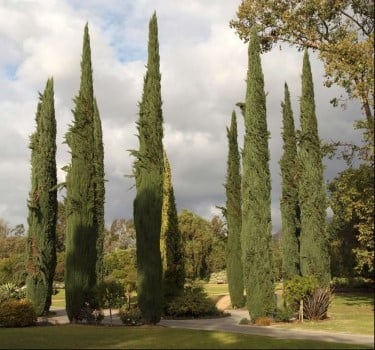University of Redlands Emergency Alert System
Alert Received: . For more information, visit: https://www.redlands.edu/alert/
University of Redlands
- Home
- Trees
- Species Accounts
- Italian Cypress
Classification
Common Names: Italian Cypress; Mediterranean Cypress
Scientific Name: Cupressus sempervirens
Family: Cupressaceae
Identification
Habit: The Italian cypress is an evergreen tree that can grow up to 115ft tall and 10ft wide! However, the tree usually averages 50 feet in height and 3 feet in width. The Italian cypress has a dense columnar crown and is symmetrical in shape.

Leaves: The Italian cypress has tiny scale-like leaves that are often dark green in color. The leaves follow a whorled arrangement and they are simple and entire.

Twigs and Bark: As a young tree, the Italian cypress has thin gray bark, which later becomes furrowed and brown-grey in color at maturity. The Italian cypress also has thin brown-grey twigs that do not droop and are not very showy.
Seed Cones: The cones of the Italian Cypress are ovoid or oblong in shape and average at about 1 inch in length. The species also happens to be monoecious, meaning that male and female cones are produced on the same plant.


Where it’s from:
Native Range: The Italian cypress originated in Persia, but it can be found in the eastern Mediterranean region in countries like Greece, Turkey, and Israel. This region experiences hot and dry summers with rainy winters as well as a semi-arid climate in the more interior (eastern) parts of its range. The species can also be grown locally and is found in the US in plant hardiness zones 7-11.

Ecological Notes: In order to develop successfully, the Italian Cypress requires full sunlight. Cypress seeds germinate under bright indirect light between 65 and 70 degrees F but can take up to 50 years to reach full maturity! As a result, the plant species is often propagated via tissue cuttings but can be grown from seeds if they are scarified and stratified. Fortunately, the Italian cypress can grow in a variety of soils including: clay, sand, loam, and alkaline and acidic soils. Due to its narrow columnar shape, the Italian Cypress requires little pruning and is relatively easy to maintain. The Italian Cypress can also withstand drought stress and forest fires, making it an optimal plant to grow in dry, hot climates. Root rot, however, is fairly common in the species due to poorly drained soil. In addition, the Italian Cypress is susceptible to cankers induced by fungi, mites, and bagworms.


What we use it for:
The Italian Cypress has many economic uses from its essential oils to its wood. The species’ essential oils have air freshening properties that are often used as perfumes. The plant’s leaves are also used in the cosmetics industry for production of shampoos and soaps with anti-seborrheic and anti-dandruff properties. Because the Italian Cypress has rot resistant wood, it is often used to build furniture and coffins. The Italian Cypress also has many medicinal properties. The species generally produces many secondary metabolites, which constitute an important source of many pharmaceutical drugs. The plant possesses antibacterial, antifungal, antiviral, antiparasitic, insecticidal, antioxidant, wound healing, anticancer, estrogenic, and anticoagulant compounds. The plant’s leaves and cones were traditionally used for head colds, coughs, and bronchitis. The extract of the cypress was also incorporated into various ointments and suppositories and used to treat hemorrhoids, varicose veins, and venous circulation disorders.
References
Biographer: Ariel Bina ’19, BIOL 336: Botany, Spring 2017
 © 2017 HalieWestPhotography
© 2017 HalieWestPhotography